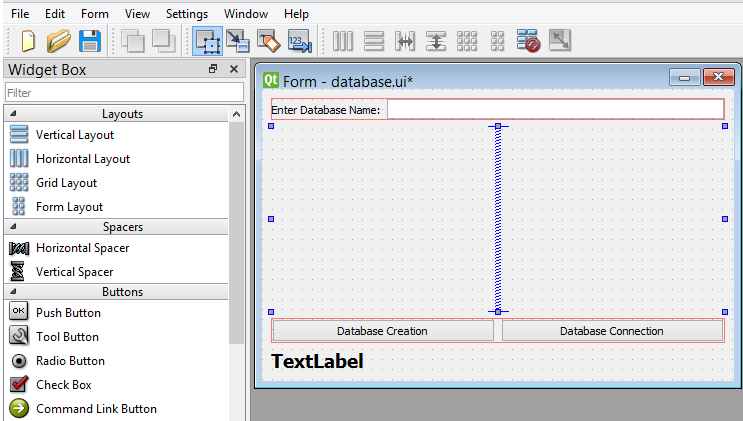
#Pyqt5 creator password#
Second, set the echo mode of the password field to Password: The following table lists the fields, their types, and names: Field In the Property Editor, you can set a name for the widget e.g., login_formĪnd the window title: Adding widgets to the login formįirst, add the widgets QLabel, QLineEdit, and QPushButton to the form: You can set the layout for the widget, and drag and drop widgets from the Widget Box to the form. Second, select the Widget from the templates\forms and click the Create button: We’ll create a simple login form using the Qt designer and load it into our Python program.įirst, select File > New or press Ctrl-N keyboard shortcut to open the New Form dialog: The Qt Designer will look like this: Creating a login form
#Pyqt5 creator code#
Launch the Qt Designerįrom the Shell, type the designer command to launch the Qt Designer: (pyqt6-env) d:\pyqt6\pyqt6-env\Scripts>designer Code language: Python ( python ) ui) generated by Qt Designer to a Python file (. The pyuic6 is a tool for converting a design file (. Third, execute the pyuic6 command (within the pyqt6-env virtual environment) to check the version: pyuic6 -V Code language: Python ( python )Īnd you’ll see the following output: 6.1.
#Pyqt5 creator install#
The pyqt-tools package will install the Qt Designer in the following location: D:\pyqt6\pyqt6-env\Lib\site-packages\qt6_applications\Qt\bin\designer.exe Code language: Python ( python ) Second, install the pyqt6-tools package that contains the Qt Designer and other related tools: pip install pyqt6-tools Code language: Python ( python ) It’ll show the following on Windows: (pyqt6-env) d:\pyqt6\pyqt6-env\Scripts> Code language: Python ( python ) Install PyQt6 and its toolsįirst, execute the following command to install pyqt6 package in the pyqt6-env virtual environment: pip install pyqt6 Code language: Python ( python ) Third, activate the virtual environment by executing the activate.bat file: activate Code language: Python ( python ) Second, navigate to the Scripts folder: cd Scripts Code language: Python ( python ) Second, create a virtual environment using Python 3.9 using the venv module: python -m venv D:\pyqt6\pyqt6-env Code language: Python ( python ) Activate the virtual environmentįirst, navigate to the pyqt6-env virtual environment directory: cd D:\pyqt6\pyqt6-env Code language: Python ( python )

Create a new virtual environmentįirst, create a directory to host the PyQt6 projects e.g., D:\pyqt6 mkdir pyqt6 Code language: Python ( python ) For example, you can install Python 3.9 in the C:\Python39 directory on Windows. Note that if you have Python 3.10 or higher, you can install Python 3.9 in a separate directory and use PyQt6 tools. Therefore, you need to install Python 3.9 to continue the tutorial. PyQt6 tools are compatible with Python 3.9 at the time of writing this tutorial.
#Pyqt5 creator how to#
You can open this and see that it contains the code used to create the GUI you made with drag and drop.Summary: in this tutorial, you’ll learn how to use the Qt Designer tool to design user interfaces for PyQt applications. Now you should see a file in that same directory as your. Open up a command prompt window in that location. Save your work somewhere you can find it (you'll notice it saves as a. Once you have created a GUI and want to export it to the python code you need to follow the steps below. Now you can launch the designer app and start creating a GUI.

I would recommend creating a shortcut of this and placing it on your desktop. If you are unable to locate this you can try doing a file search of your entire C drive.įrom here simply scroll down until you find designer. It should be located in your python install folder under > Lib > site-packages > pyqt5-tool > designer Now that we have QtDesigner installed we actually need to find its install location on our computer. pip install pyqt5 - toolsĪnd if that doesn't work you can try: pip3 install pyqt5 - tools Otherwise run the following command in your command prompt. QtDesigner comes with the pip package pyqt5-tools so if you installed it in the previous tutorials you're good to go. This makes it very easy to create GUI's, especially simple ones. One you have built and saved the application you can run a command line tool that will turn your GUI into python code. QtDesigner is a program made by the makers of Qt and PyQt that allows you to build GUI applications with drag and drop. This pyqt5 tutorial will show you how to use the QtDesigner to create GUI applications within a drag and drop interface.


 0 kommentar(er)
0 kommentar(er)
